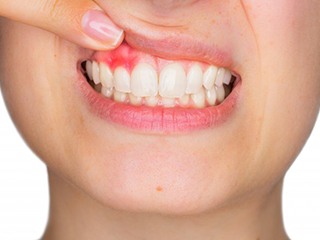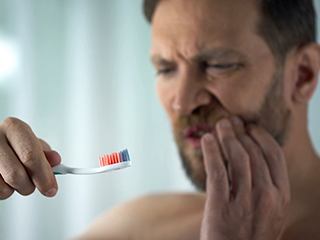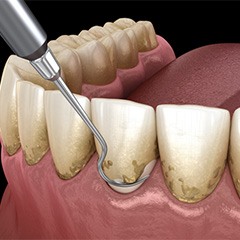Periodontal Disease Treatment - Edison, NJ
Protecting Your Smile from Serious Infection
Periodontal disease (also known as gum disease) is one of the most common health problems on the plant, as well as the leading cause of adult tooth loss in the United States. While the infection starts out with mild symptoms, untreated cases can quickly threaten your smile and your overall health as well. Thankfully, our team at Rosenfeld Dental Associates offers several treatment options for combating the dangerous effects of gum disease at every stage. Don’t hesitate to contact our Edison, NJ location if you’re experiencing common symptoms, such as bleeding gums.
What Is Periodontal Disease?

Simply put, periodontal disease is an infection in the gums. It all begins with a buildup of plaque and tartar on the teeth. This accumulates bacteria, and if not cleaned out thoroughly and regularly, the bacteria can attack the gums. The initial stage of gum disease is called gingivitis, which is where the bacteria are aggravating the gum tissue in the mouth. This causes uncomfortable symptoms, but gingivitis can be reversed.
However, left untreated, gingivitis will progress into periodontitis. This second stage of periodontal disease is marked by the spreading and strengthening of the bacteria. At this point, the infection can cause the gums to pull away from the teeth and can also damage the jawbone to cause tooth loss. Periodontitis cannot be cured, but it can be managed with the help of a professional.
Symptoms of Gum Disease

Preventing gum disease and minimizing its complications to your oral health begins with identifying the symptoms. The sooner you recognize the warning signs of gum disease, the faster you can begin treatment.
Common symptoms of gingivitis include:
- Puffy gums
- Gums that are bright red
- Persistent bad breath
- Tooth sensitivity
- Easily bleeding when brushing or flossing
Meanwhile, common symptoms of periodontitis are:
- Gum recession, or teeth that look longer than normal
- Discomfort when chewing
- Gums that bleed very easily, even when gently brushing
- Loose teeth, or teeth that fall out
- A small bump on the gums, called an abscess
How Do We Treat Periodontal Disease?

At Rosenfeld Dental Associates, we offer a number of ways to combat this common oral health issue. If you suspect you have gum disease, give us a call right away to scheduke your appointment. We also check for periodontal disease during each regular checkup. If gum disease is found, we will recommend a treatment depending on your specific circumstances. This could include scaling and root planing, microscopic monitoring, or antibiotic therapy
Microscopic Monitoring

Because periodontal disease is a bacterial infection, we routinely sample all our patients for the presence of disease-associated bacteria. In this non-invasive procedure, our dentists (or hygienists) will obtain a sample of the bacteria growing under your gum and observe it with the aid of a specially designed phase contrast microscope. This allows us to determine if a patient is harboring bacteria associated with periodontal disease.
Preventive Measures Against Gum Disease

First, microscopic monitoring allows us to diagnose the potential for gum disease before any breakdowns occur or symptoms appear. We can advise a patient how to naturally and non-surgically eliminate potentially problematic germs, and the disease can essentially be cured before any damage occurs. You'll never have to experience the bleeding, bad mouth odor, or loose teeth that often accompanies gum disease.
Non-Surgical Treatment of Gum Disease

If breakdown has already started to occur due to periodontal disease, the identification of the bacterial problem allows us to treat the disease with the goal of eliminating the cause of the disease: the bacteria. Once the cause is eliminated, the body can heal itself naturally. This technique is completely non-surgical. It is effective even in the most advanced cases; it allows patients to be cured of periodontal disease without the pain, disfigurement, and tooth sensitivity that can follow surgical procedures. Better yet, it is not nearly as costly!
Scaling & Root Planing

Scaling and root planing, more commonly known as deep cleaning, is a complete bacterial debridement that is aimed at eliminating the cause of gum disease. Dr. Rosenfeld will target harmful bacteria underneath the gum tissue and clean the area using small instruments and anti-bacterial solutions to eliminate the primary cause of the disease and keep your gums and bone healthy. In some cases, like for patients with gingivitis, this treatment can reverse the condition altogether.
Scaling & Root Planing: The Most Common Gum Disease Treatment

Dr. Rosenfeld often recommends scaling and root planing once gum disease has surpassed a certain severity, leading to other symptoms besides bleeding gums while flossing. Our team will make you aware of why we’re recommending scaling and root planing in Edison before conducting the procedure, helping you understand the importance of treatment. Then, once you consent to moving forward, we’ll get to work restoring the health of your gums!
The Scaling & Root Planing Process

Scaling and root planing typically takes place over the course of two appointments. First, one of our dental hygienists will thoroughly remove all plaque and tartar from the surface of the teeth, as far down as the pockets of the gums. The gum pockets are often where the bacteria collect and is the origin of the infection.
After scaling is complete, we’ll go on to the root planing process. This involves smoothing out the roots of the teeth hidden below the gumline by removing hardened deposits of bacteria. The goal is to allow the gums to healthily reattach to the teeth to continue providing this vulnerable area with much-needed protection from bacteria.
Aftercare Tips for Deep Cleanings

After your deep cleaning, you can expect to feel numb for several hours due to the local anesthetic that we’ll administer at the beginning of your treatment. Avoid eating for at least a couple of hours following your procedure so you don’t accidentally bite your tongue or cheek. For several days after your treatment, rinse with saltwater to keep your mouth clean and continue brushing and flossing like normal, being careful around your gums. If you have any concerns or questions, don’t hesitate to get in touch with our team.
Antibiotic Therapy

In order to maximize treatment results for patients with gum disease, our team combines anti-bacterial therapy with the above services. Often, just antiseptics are used but sometimes an antibiotic or a combination of antibiotics is used. We prescribe specific toothpastes depending on your diagnoses. A personalized home care regimen is developed for each patient. Our goal is to keep your smile infection-free for a lifetime.

